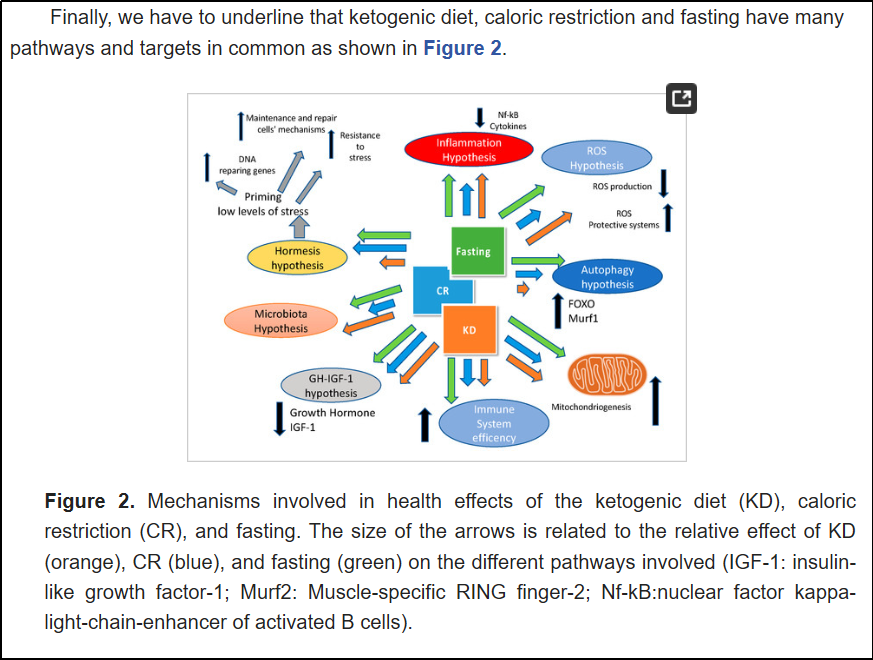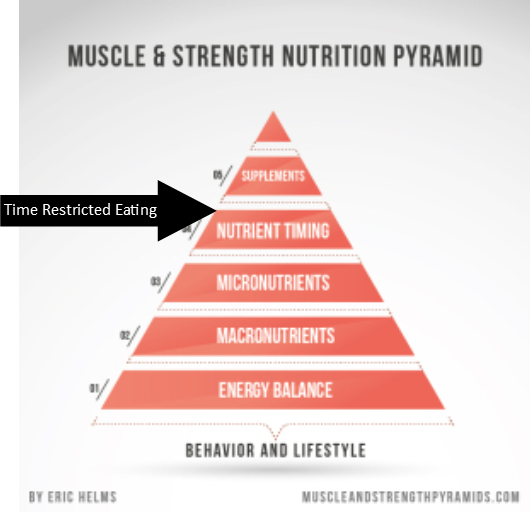Time-restricted feeding (TRF) is eating within a relatively small window of time, which is typically 8 to 10 hours and is done daily. This type of eating pattern often falls under the umbrella of Intermittent Fasting (IF). However, due to its daily use, it really does not qualify as “intermittent”. It is related to IF due to the duration of fasting (the reduced eating time-frame) and seems to be an outgrowth of the research on IF as well as circadian biology. This latter aspect is at the heart of TRF with the basic premise; eating should closely align with certain circadian rhythms of the body and doing so can have positive metabolic benefits. Conversely, eating out of sync of these circadian rhythms can have negative effects (Bae et al 2019; Chaix et al 2019; Paoli et al 20019; ). At this point (October 2019), is the research showing that there are significant benefits of TRF for humans? The short and exceptionally boring answer is maybe.
Here is what I considered to come to that conclusion.
Danny Lennon’s recent presentation: Circadian eating-evaluating the impact of meal timing, feeding windows, and calorie distribution.
https://sigmanutrition.com/circadian-lecture/
Alan Aragon’s recent article; Early time-restricted feeding: hype vs. data in the September issue of AARR
Then the actual research.
There have been a few very recent review papers on the topic, including a May 2019 in-depth review; Time-restricted eating to prevent and manage chronic metabolic diseases. One of the authors, Satchidananda Panda, seems to be “the dude” when it comes to circadian biology, which includes looking at how feeding times affect health.
Then I read most of the recent studies on TRF done with humans* (Anton et al 2019; Gabel et al 2018; Hutchison et al 2019; Jamshed et al 2019; Tinsley et al 2019 ).
With that in mind here is why I said, maybe.
There is no dispute that there are biological rhythms of the body and our behaviors, such as sleep, exposure to light and eating times can potentially have positive or negative effects on metabolic functioning (Roenneber et al 2016). The following two diagrams highlight the potential positive effects of TRF.
Figure 3 (Chaix et al 2019, p.2.11)
Figure 2 (Paoli et al 2019, p.10)
The positive effects are potentially coming from better digestion and nutrient utilization, hormonal changes (ie., insulin and leptin), autophagy, and gene expressions (Chaix et al 2019; Paoli et al 2019). As Paoli and colleagues highlight in their diagram, the potential benefits can come TRF/fasting as well as other dietary aspects, such as overall calorie restriction as well as ketosis. At this time the understanding of the mechanisms TRF effects in humans is still not clear (Paoli et al 2019).
When it comes to TRF, at this time, the preponderance of evidence comes from studies on rodents, not humans, which means there is still a paucity of understanding of how it will actually affect us. This lack of a solid understanding of the effects on humans was clearly highlighted in a few recent review papers on the subject (Bae et al 2019; Chaix et al 2019, Paoli et al 2019). For example, the conclusion from a 2019 review paper on the topic sums it up well;
“In summary, TRE has opened new avenues to assess the effects of the timing of eating on metabolism, physiology, and behavior. Although animal experiments have produced great results in preventing or reversing chronic metabolic diseases, the underlying mechanisms remain to be explored. More rigorous human studies are also needed to assess the mechanisms and efficacy for TRE in a wide range of diseases.” (Chaix et al, p.12.19, emphasis added)
When it comes to what can have strong effects on health, and more specifically body weight regulation, it is important to keep TRF in context (perspective?) of other dietary and lifestyle habits. The following is a good diagram illustrating where TRF likely falls on the hierarchy of importance.
Some key things to consider in determining how important the TRF aspect is for a particular person, include exercise (when, what time, duration, frequency), macronutrient distributions, overall quality of the diet and the king of all variables, total calorie intake. With respect to calories, two major confounders with TRF studies are calorie intake and weight loss. There is often a spontaneous reduction in overall calorie intake and weight loss (a good thing) relative to the non-TRF group. The challenge is knowing if the benefits from TRF are from this aspect (very good evidence that calorie restriction and weight loss cause all kinds of benefits) or something to do with the fasting or the timing of meals. More studies are needed that are matched for calories and weight changes to help figure this out. Furthermore, if peak athletic performance is the goal, it is likely that TRF is not an ideal eating pattern. In this case, an intermittent fasting regimen could be a better choice if looking to get the benefits of fasting.
TRF typically means eating within an 8 to 10 hour window. The next unanswered question is when in the day should this window happen. The prevailing idea is it should happen earlier in the day, (i.e., first meal at 8 am and last meal at 4pm, for an 8 hour window ) due to certain circadian rhythms (Chaix et al 2019). However, the RCT’s looking at early versus late timing (eTRF vs LTRF, respectively), are not finding a clear advantage for eTRF (Hutchison et al 2019). This early eating aspect also comes from the ubiquitous idea that eating breakfast is important for health and weight. However, this comes largely from epidemiology, which has found associations with eating breakfast and less disease and lower weight and conversely not eating breakfast and higher weights (Paoli et al 2019). When looking at RCT’s, the evidence does not support the idea that eating breakfast is needed to be healthy or reach a healthy weight, in fact, adding this meal tends to have the opposite effect (Sievert et al 2019). When it comes to eating breakfast, there is no need to eat this meal to be able to lose weight or maintain a healthy weight. Finally, when it comes to timing, is the concept that people can be genetically, or adapted to, being an early (lark) or late (owl) type of person, referred to as chronotypes (Paoli et al 2019; Phillips 2009.). This means our behaviors (eating, exercise, etc) can modify (within a range, we are not nocturnal animals, so night shift work, even if all strategies are utilized to adjust to this schedule are consistently done, will still likely have some negative physiological and psychological effects) when the biological rhythms will occur, referred to as entrainment (Roenneber et al 2016). A person’s chronotype could also determine their best timing.***
Finally, how many meals in the 8 to 10 hours? At this time there is no clear answer. The evidence is pointing to 2 to 4 meals a day and one meal, on a regular basis, is likely not a good choice. Related to meal frequency is meal consistency. Should these meals be eaten on a regular schedule, (ie., 8am, noon, and 4pm, every day) or some haphazard pattern resulting in meals at a widely variable times each day? Regardless of TRF or not, a fairly regular meal pattern does seem ideal. However, the research on intermittent fasting does highlight the fact that there can be occasional variation, such as the 5:2 plan of IF, which does modify meal frequency twice a week, and shows some health related benefits. These are important variables, but it is equally important to keep them in perspective of other variables (see hierarchy diagram).
In conclusion, here is where I think the evidence is currently. There is still a lack of human research to say that TRF is of major importance for overall health promotion. However, based on the current human evidence and the extensive research done on other animals, it does seem likely to play at least some role in the promotion of disease or health. If a person is dealing with blood sugar issues (pre-diabetes and diabetes), eating within an early 8 to 10 hour window will likely confer some additional benefits (still need to do the foundational aspects as well, see above). Furthermore, if a person is not able to do some of the other lifestyle/dietary aspects at the base of the hierarchy, such as exercise, then TRF could play a more substantial role in promoting health. When it comes to overall health promotion TRF seems likely to be a good thing. Additionally, when it comes to body weight regulation, TRF is likely ONE type of meal plan that can be helpful for losing weight and maintaining a healthy weight. What I like about the research on TRF, along with intermittent fasting, is it gives more choices (flexibility) of eating patterns that can be good for health and weight. When it comes to diet modifications, TRF seems to be a relatively simple one, which by itself, could have some positive effects. But, at the end of the day, when it comes to losing weight (bodyfat) and maintaining a healthy weight, it is still about how many calories you ingest relative to how many you burn, which is really about consistency. If TRF helps you consistently eat healthy and eat in a way that causes weight loss (if that is your goal), then go for it, but if it seems to make things harder then I wouldn’t worry that you are not doing it.
*from the Chaix review, there are 8 human TRF studies published at this time. The authors also state that many more are underway, so we should have more data soon.
**breakfast is usually referring to a meal eaten soon after waking in the morning and not necessarily the first meal of the day, however, technically, eating the first meal many hours after waking would still be the meal that “breaks the fast”
***If you are interested in finding out your chronotype, the following is one questionnaire tha can help determine this; https://thepowerofwhenquiz.com/
References
Anton, S. et al (2019). The effects of time restricted feeding on overweight, older adults: a pilot study. Nutrients; 11: 1500.
Aragon, A. (2019). Early time restricted feeding: hype vs. Data. AARR, September: 2-5
Bae, S. et al (2019). At the interface of lifestyle, behavior, and circadian rhythms: metabolic implications. Frontiers in Nutrition: 6:132.
Chaix, A. et al (2019). Time-restricted eating to vent and manage chronic metabolic diseases. Annual Reviews Nutrition; 39: 12.1-12.25
Gabel, K. et al (2018). Effects of 8-hour time restricted feeding on body weight and metabolic disease risk factors in obese adults: a pilot study. Nutrition and Healthy Aging; 4: 345-353.
Hutchison, A. et al (2019). Time-restricted feeding improves glucose tolerance in men at risk for type 2 diabetes: a randomized crossover trial. Obesity; 27: 724-732.
Jamshed, H. et al (2019). Early time-restricted feeding improves 24-hour glucose levels and affects markers of circadian clock, aging, and autophagy in humans. Nutrients; 11: 1234.
Moro, T., et al (2016). Effects of eight weeks of time-restricted feeding (16/8) on basal metabolism, maximal strength, body composition, inflammation, and cardiovascular risk factors in resistance-trained males. Journal of translational medicine, 14(1), 290. doi:10.1186/s12967-016-1044-0
Paoli, A. et al 92019). The influence of meal frequency and timing on health in humans: The role of fasting. Nutrients; 11: 719.
Phillips, M.L. (2016). Circadian rhythms: Of owls, larks, and alarm clocks. Nature; 458: 142-144.
Roenneberg, T. et al (2016). The circadian clock and human health. Current Biology; 26: R432-R443.
Sievert, K. et al (2019). Effect of breakfast on weight and energy intake: systematic review and meta-analysis of randomized controlled studies. BMJ; 364: 142.
Tinsley, G. et al (2019). Time-restricted feeding plus resistance training in active females: a randomized trial. AJCN; 110(3): 628-640.



